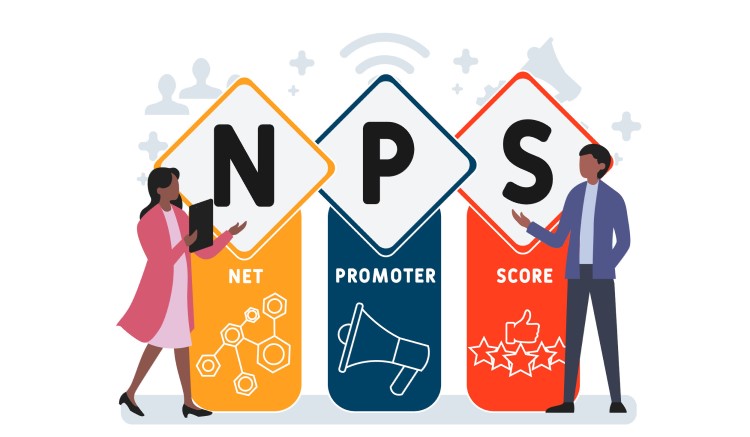The Net Promoter Score (NPS) is a key metric used by businesses to measure customer satisfaction and loyalty. By asking a simple question—how likely a customer is to recommend a company’s product or service—NPS provides valuable insights into the overall customer experience. This score helps businesses understand how well they are meeting customer needs and identifies areas for improvement. NPS has become a popular tool for evaluating customer satisfaction across industries, helping companies track their performance and improve customer loyalty.
NPS is based on a scale from 0 to 10, where customers rate how likely they are to recommend the company to others. Based on their responses, customers are categorized into three groups: Promoters, Passives, and Detractors. Promoters give scores of 9 or 10, showing strong satisfaction and a high likelihood of recommending the business. Passives give scores of 7 or 8 and are generally satisfied but not enthusiastic enough to recommend the company. Detractors give scores of 0 to 6, indicating dissatisfaction and the potential to harm the company’s reputation through negative feedback.
By calculating the percentage of Promoters and subtracting the percentage of Detractors, businesses arrive at their Net Promoter Score. A positive NPS means that a company has more Promoters than Detractors, while a negative score indicates more Detractors than Promoters. This simple calculation offers a clear snapshot of overall customer satisfaction.
Why Net Promoter Score Matters
The Net Promoter Score matters because it directly links customer satisfaction to business growth. Promoters are not only loyal customers but also active advocates for your brand. They are more likely to make repeat purchases, refer others, and contribute to organic growth through positive word-of-mouth marketing. On the other hand, Detractors may damage a company’s reputation by sharing negative reviews or discouraging others from using the service.
For businesses, tracking NPS allows them to monitor customer loyalty over time. When the NPS improves, it signals that the company is delivering a positive customer experience, which can lead to higher retention rates and increased customer lifetime value. Conversely, a declining NPS may indicate issues with the product, service, or customer interactions, giving companies a clear signal to address these concerns.
In addition to improving customer retention, a strong NPS is often correlated with increased revenue. Research shows that companies with high NPS scores grow faster than their competitors, as loyal customers drive both repeat business and new customer acquisition. Therefore, regularly measuring NPS can help businesses maintain a competitive edge by identifying opportunities to enhance customer satisfaction.
How to Calculate Net Promoter Score
To calculate Net Promoter Score, businesses need to gather responses to the key NPS question: “On a scale of 0 to 10, how likely are you to recommend our company/product/service to a friend or colleague?” Based on these responses, categorize customers into Promoters, Passives, and Detractors.
Next, calculate the percentage of respondents who fall into each group. For example, if 60% of respondents are Promoters, 20% are Passives, and 20% are Detractors, the NPS formula is:
NPS = % of Promoters – % of Detractors
In this case, the NPS would be 40 (60% Promoters minus 20% Detractors). The score ranges from -100 to +100, with higher scores indicating better customer satisfaction and loyalty. Companies should aim to maximize the number of Promoters and minimize the number of Detractors to achieve a high NPS.
Using NPS to Improve Business Performance
While calculating the Net Promoter Score is straightforward, the true value comes from using the data to drive business improvements. A company can identify what motivates Promoters to advocate for their brand and understand why Detractors are dissatisfied. This feedback is invaluable for improving products, services, and customer interactions.
First, companies should focus on turning Passives into Promoters by identifying and addressing the gaps in their experience. Passives are generally satisfied but lack the enthusiasm of Promoters. Understanding their concerns and providing an enhanced experience can convert them into loyal, vocal supporters.
Next, businesses should actively seek feedback from Detractors. Detractors may have had a negative experience, but this also presents an opportunity for recovery. By addressing their pain points and offering solutions, companies can rebuild trust and potentially turn these dissatisfied customers into advocates.
Additionally, tracking NPS over time allows companies to measure the impact of improvements. As businesses implement changes based on customer feedback, they can monitor whether these actions lead to an increase in NPS. Over time, consistent improvements can lead to higher customer retention and a stronger brand reputation.
Challenges in Using NPS
Although NPS is a valuable tool, it has its limitations. One challenge is that it provides a high-level view of customer satisfaction without revealing specific details about customer experiences. While NPS identifies the overall sentiment, businesses need to gather additional qualitative feedback to fully understand why customers are Promoters or Detractors.
Another challenge is that external factors, beyond a company’s control, can influence NPS. For instance, a negative economic climate or industry trends might impact customer sentiment, even if the company’s service remains consistent. As a result, businesses should consider NPS alongside other customer satisfaction metrics to get a more complete picture of customer loyalty.
Despite these challenges, NPS remains a valuable tool for tracking customer loyalty and identifying opportunities for improvement. When used effectively, it provides a clear signal of customer satisfaction, helping businesses take proactive steps to enhance their products, services, and customer relationships.
The Value of Measuring Net Promoter Score
The Net Promoter Score is a powerful metric for understanding customer satisfaction and loyalty. By focusing on customer recommendations, businesses gain a clear view of their performance and can identify areas for improvement. NPS allows businesses to track customer sentiment over time, driving improvements that strengthen relationships and foster long-term growth.
Regularly calculating and analyzing NPS helps businesses understand their customers better, respond to feedback, and create loyalty-building strategies. These actions increase customer retention, promote brand advocacy, and boost revenue growth. In today’s competitive environment, monitoring and improving NPS is essential for any business looking to enhance its customer base and stay ahead.


